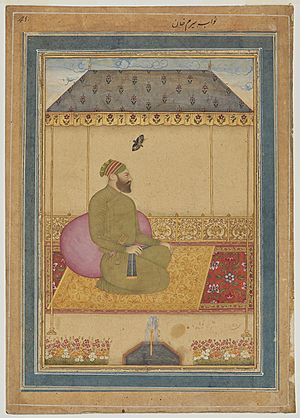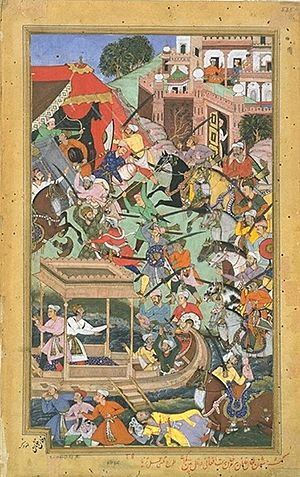Bairam Khan facts for kids
Quick facts for kids
Bairam Khan
|
|
|---|---|

Portrait of Bairam Khan, c. 1710-1740.
|
|
| Vakil of the Mughal Empire | |
| In office 1556 – March/April 1560 |
|
| Monarch | Akbar |
| Succeeded by | Munim Khan |
| Regent of the Mughal Empire | |
| In office 1556 – March/April 1560 |
|
| Monarch | Akbar |
| Personal details | |
| Born | 18 January 1501 Badakhshan (present-day Afghanistan, China or Tajikistan) |
| Died | 31 January 1561 (aged 60) Patan, Sultanate of Gujarat (present-day Gujarat, India) |
| Spouses | Jamal Khan's daughter Salima Sultan Begum |
| Children | Abdul Rahim |
| Profession | Chief advisor of Akbar, Military commander and commander-in-chief of Mughal army and Mughal Statesman |
| Military service | |
| Allegiance | Mughal Empire |
| Years of service | c. 1517/1518–March/April 1560 |
| Commands | Mughal Army |
| Battles/wars | Battle of Ludhiana Battle of Khanwa Battle of Ghaghra Siege of Sambhal Battle of Kannauj Battle of Machhiwara Battle of Sirhind Second Battle of Panipat Battle near Gunecur (as the leader of a rebel faction of the Mughal Army) |
Muhammad Bairam Khan (born January 18, 1501 – died January 31, 1561), often called Bairam Khan, was a very important leader in the Mughal Empire. He was a great military commander and a powerful advisor to the Mughal Emperors Humayun and Akbar. Bairam Khan was also Akbar's guardian, main teacher, and most trusted friend. Akbar honored him with the title Khan-i-Khanan, which means "King of Kings." Bairam Khan was a strong general who helped bring back Mughal power in India.
Contents
Who Was Bairam Khan?
Early Life and Family
Bairam Khan was born in a region called Badakhshan in Central Asia. His family, the Baharlu Turkoman clan, had served the Mughal emperors for a long time. Bairam Khan himself started working for Babur, the first Mughal Emperor, when he was just 16 years old. He played an active role in the early Mughal conquests of India.
Serving Emperor Humayun
Bairam Khan helped a lot in establishing the Mughal Empire under Emperor Humayun. He was put in charge of the royal seals and took part in many military campaigns across India. In 1540, during the Battle of Kannauj, he was captured by Sher Shah Suri's forces. However, he managed to escape and rejoined Humayun in 1543. He even went with Humayun during his time in Persia and helped conquer Kandahar, where he served as governor for nine years. In 1556, he was a key commander in Humayun's effort to take back Hindustan.
Bairam Khan as Akbar's Regent
When Emperor Humayun died on January 27, 1556, Bairam Khan was leading a military campaign in Punjab. He was Prince Akbar's guardian and the commander-in-chief of the Mughal army. To keep the Mughal Empire stable, Bairam Khan kept Humayun's death a secret for a while. He sent messages saying Humayun was recovering and even had a loyal cleric, Mullah Bekasi, pretend to be the emperor in public. This gave time for Akbar to be crowned.
On February 14, 1556, Akbar became the new Mughal Emperor. His first act was to make Bairam Khan his Vakil (Prime Minister). He also gave him the important titles of Khan-i-Khanan and commander-in-chief. Under Bairam Khan's leadership, the Mughal army moved to Jalandhar. They stayed there for five months and pushed back Sikandar Shah Suri, a rival ruler.
However, the Mughals then faced a bigger threat from Hemu, a powerful minister of Adil Shah Suri. Hemu quickly captured important cities like Gwalior, Delhi, and Agra. Bairam Khan left a small force to watch Sikandar Suri and moved the main Mughal army towards Sirhind.
On November 5, 1556, the Mughals fought Hemu's army in the Second Battle of Panipat. After a fierce battle, the Mughals won. Hemu was captured and killed, and Delhi and Agra were taken back. After this victory, Akbar and Bairam Khan continued their campaign against Sikandar Suri, who eventually surrendered in July 1557.
Bairam Khan's Dismissal
As time went on, the relationship between Bairam Khan and Akbar became difficult. Bairam Khan started making important decisions without asking the Emperor first. For example, he dismissed a senior Mughal official without consulting Akbar. Akbar also felt that his own spending was limited, while Bairam Khan's servants were becoming rich. Bairam Khan also became easily annoyed and punished some of Akbar's favorite servants.
After these incidents, Akbar decided that Bairam Khan could no longer stay in his position. In March or April 1560, Akbar told him he could either retire and stay in the palace or go on a pilgrimage to Mecca. He was allowed to take land so his servants could send him money each year.
Bairam Khan's Rebellion
At first, Bairam Khan decided not to rebel. However, his political rivals, Maham Anga and her son Adham Khan, sent another official, Pir Muhammad, to follow him and force him to go to Mecca. This insult made Bairam Khan angry, and he decided to rebel.
Bairam Khan left his family in a fortress and headed towards Jalandhar, planning to take Lahore. Akbar had to fight his former mentor. He sent his foster father, Shams-ud-din, with an army to stop Bairam Khan. Near the village of Gunecur, Bairam Khan's forces fought Shams-ud-Din. Even though Bairam Khan had a smaller army, he fought bravely but was eventually defeated.
Bairam Khan managed to retreat and later surrendered to Akbar. Akbar treated him with great respect. He gave Bairam Khan options: stay at court as an advisor, choose land for himself, or continue his pilgrimage. Bairam Khan chose to continue his pilgrimage.
Bairam Khan's Death
While traveling through Gujarat, Bairam Khan was killed on January 31, 1561. He was at a religious site near Anhilwad Patan. A group of Afghans, led by Mubarak Khan Lohani, attacked him. Mubarak Khan's father had been killed fighting the Mughals in an earlier battle. According to historical records, the Afghans pretended to pay their respects to Bairam Khan, so he let them come close. Bairam Khan died while saying a prayer. His body was found by locals and buried near a Sufi saint's tomb.
Bairam Khan's son and wife managed to escape to Ahmedabad. Akbar heard about their situation and had them brought to Agra. Bairam's wife, Salima, who was also Akbar's cousin, later married Akbar. Bairam's son, Abdul Rahim Khan-i-Khanan, became an important part of Akbar's government and was one of the "nine gems" (important advisors) in Akbar's court.
Personal Life
Bairam Khan was a Shia Muslim. Some of the Sunni Turkic nobles did not like him because of this. Even though he was Shia, he attended Friday prayers at the mosque of a famous Sufi leader. He also promoted Sheikh Gadai, the son of a court poet, to a high position as Chief Justice in 1559.
Marriages
Bairam Khan had two wives. One was the younger daughter of Jamal Khan. His other wife was Salima Sultan Begum, who later married Emperor Akbar after Bairam Khan's death.


